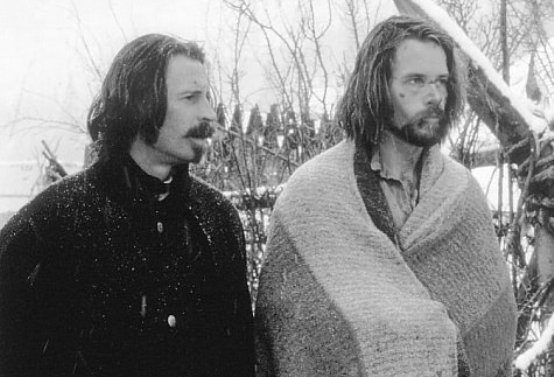The Man Who Ate Liberty Valance

1999’s “Ravenous” turns up on a lot of lists of underrated horror movies. It’s hard to get people to take you seriously when your plot is, “Guy Pearce eats people in the Old West.” But now that I’ve finally taken advantage of “Ravenous”‘s availability through Netflix streaming, I can tell you: This movie is criminally underrated. It’s not just a creepy, haunting cannibal Western from the producer of “Donnie Darko,” although that sounds great to me; it’s also an exploration of the temptations of power and the acceptance of powerlessness.
The movie is set in the aftermath of the Mexican-American War. Captain John Boyd (Pearce) was so terrified by battle that he played dead—and, posing as a corpse, he was dragged behind enemy lines, where he staged a one-man ambush. His superiors pin a medal on him, but make sure he knows how much they really despise him for his initial loss of nerve. They send him away to a remote California outpost.
Already in these first fifteen minutes so many of the movie’s strengths are on display. The music is distinctive—Western in style, much less plangent than most horror scores, imaginative and non-intrusive. Over the course of the movie it will become steadily more modern. The movie’s humor and self-awareness come through at the outpost, which is staffed by stock characters: the eccentric leader (Jeffrey Jones, feisty and fun), the praying man, the scarily enthusiastic killing machine, the drunk.
And from its first scenes “Ravenous” zeroes in on the two questions which will determine the film’s storyline: Whose stories are believed, whose versions of the truth are accepted? And is the moral life simply a choice between conquest and cowardice?
As Boyd starts to settle in at his new post, a man stumbles up to their gate–surprisingly robust for someone who’s been lost in the snow. Colqhoun (Robert Carlyle), with his eerily weaving and twitching fingers, spins a tale in which bad leadership left him and his party stranded for months in a snowbound cave, with no choice but to eat first the oxen, then the horses. Then… well, you know. Colqhoun sets off with the Californian soldiers for the cave, to rescue the few survivors. The Indians at the post mutter about the legend of the wendigo, in which a man who eats other men gains their strength but subjects himself to an insatiable hunger for more. But who listens to Indians?
Before long there are wendigos a-roamin’, just stewing and eating everybody they can find, and it’s grisly good fun. But there’s more going on here. The hints at Christian imagery aren’t just the usual horror window-dressing. If Westerns often concern the tragic replacement of chaos with order, “Ravenous” argues that order—the lawman, the soldier, the boundary fence, and the official report—is chaos.
A few years ago I noticed a trend in recent horror films which is understandable but deeply misleading. In an attempt to make monsters sympathetic and villains complex, horror films went out of their way to argue that their killers were victims: anguished, abused, acting out of old hurts. The mostly-excellent “Session 9” put this point of view in the starkest terms. When the killer finally speaks, what that tiny voice says is, “I live in the weak and the wounded.”
There are ways in which this is true. People do often hurt others because their own abuse and humiliation left them filled with rage and fear, unable to withstand the temptation to lash out, not knowing any other way to act. In some of the best of these narratives, like “Carrie,” the abuse itself is made a part of the narrative: We see the killer powerless, and then see the terrible wheels turn inside her head when she finally gains power.
But notice that Carrie becomes a killer only once she has gained power. It’s pretty much a tautology: abuse requires power. Not powerlessness. Too many horror movies, in order to yank on audience sympathy, unintentionally suggest that we should fear the weak, not the powerful. Instead of loving, protecting, identifying with, or seeking to become more like “the weak and the wounded,” the audience is encouraged to fear them. You know who actually lives in the weak and the wounded? The Crucified.
There are horror films which focus our fear on the powerful, not their victims. “Deadgirl,” for example, is a grim, rancid, sad little exploration of misogyny which is not itself misogynistic. It shows that power can shift, and bubble up unexpectedly—everybody’s able to kick somebody—but power is a prerequisite for cruelty.
“Ravenous” goes further, targeting power itself and the lust for power. It subtly uses Boyd’s history of panic and loss of nerve in battle: I don’t think it’s coincidence that the character with the experience of humiliation, disgrace, and unearned promotion is the one who most clearly identifies power as a temptation. He’s required to go beyond “playing dead”; he has to display physical and moral courage in ways which his own society and peers won’t understand or respect. The only way to win against these villains is to lose. This gives the climactic fight a certain cartoony, duck-season-rabbit-season humor (a giant bear trap?), but also real emotional impact. By the end you’re not hoping that the hero will win, or even escape; you’re hoping that he’ll lose the right way.
Comments